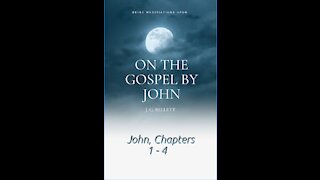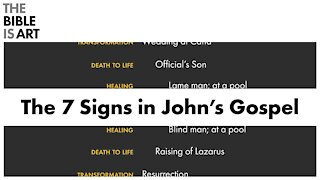Premium Only Content

The Art of Action in The Republic, Netflix's The Bodyguard, and the Gospel of John
In this video I talk about the how action work with great authors. And we look at examples in Plato's Republic, Netflix's "The Bodyguard", and the Gospel of John.
The Bible is the greatest work of literary genius. And The Bible is Art is a YouTube Channel devoted to explaining this literary art in all its sophistication, elegance, and design.
Patreon: https://www.patreon.com/thebibleisart
website: https://www.thebibleisart.com
email: thisdivineart@gmail.com
twitter: @johnbhiggins
music: Kai Engel, "Coelum" (https://www.kai-engel.com) and Blake Ewing, "Linden"
| How to Learn to Read the Bible as Literary Art |
Reading Biblical Narrative: An Introductory Guide (https://amzn.to/30LzaRa)
Narrative Art in the Bible (https://amzn.to/30RVGIb)
The Art of Biblical Narrative (https://amzn.to/3aDrIfk)
Old Testament Narrative: A Guide to Interpretation (https://amzn.to/38rcE2C)
The Poetics of Biblical Narrative (https://amzn.to/2Gh4cqE)
| Literary Structure |
Literary Structure of the Old Testament (https://amzn.to/30Jdm8X)
Style And Structure In Biblical Hebrew Narrative (https://amzn.to/2RDTTlQ)
| Genesis |
Creation: The Story of Beginnings - Grossman (https://amzn.to/2GlPwq9)
Abram to Abraham: A Literary Analysis of the Abraham Narrative - Grossman (https://amzn.to/2v7id7Z)
Narrative Art in Genesis - Fokkelman (https://amzn.to/2ulmd4t)
A Commentary on the Book of Genesis (Part I) - Cassuto (https://amzn.to/2NOAhdt)
A Commentary on the Book of Genesis (Part II) - Cassuto (https://amzn.to/2Gcuk6d)
Genesis: A Commentary - Waltke (https://amzn.to/2vaBvt7)
The Gospel of Genesis: Studies in Protology and Eschatology - Gage (https://amzn.to/2RGjRFo)
Abraham and All the Families of the Earth: A Commentary on the Book of Genesis 12-50 - Janzen (https://amzn.to/2TVyCqJ)
Genesis 1-15, Volume 1 - Wenham (https://amzn.to/2TQnYRO)
Genesis 16-50, Volume 2 - Wenham (https://amzn.to/3aDY21J)
| Transcription |
I never really understood what the fuss was about Plato, the philosopher. You’d hear everyone say he was one of the best or the best philosopher whoever lived, or you’d hear that quote that all of western philosophy is footnotes to Plato. But when I read him, and I think I understood him, I didn’t get what the big deal was.
That was until one of my professors told me something that made me realize I had been reading Plato all wrong.
You see, Plato wrote dialogues, or that’s what they’re commonly referred to as, but they’re are stories where the characters talk a lot, which is why we call them dialogues. They’re not like how most modern philosophy is done with proposition and syllogisms, Plato wrote stories, that had characters, doing things.
And I always assumed that putting them in the form of stories was just icing on the cake, a really unnecessary shell around the real philosophy.
But then I started listening to Dr. Warren Austin Gage. And Dr. Gage, influenced by the work of Leo Strauss, showed me that the actions in Plato’s Dialogues, the things that the characters do, are just as philosophically important as the words.
For instance, The Republic opens with Socrates going down to the Piraeus, a seaside city. Before, I would have thought that this was inconsequential scene setting. But I realized that this action was an allusion or, more precisely, a foreshadowing of another story later in the Republic, the Allegory of the Cave in Book 10. Socrates tells an allegory where men are chained to the wall in a cave, watching shadows of creatures on the wall, thinking that the shadows are the reality, because that’s all they see. As they are chained to the wall they can’t see that the creatures are real and the shadows are not. This is an image of most people in the world. Most people think that the realities of the world, tables, cars, are the ultimate reality, but for Socrates, they’re not. One man is released to leave the cave and go up to the sunlit earth. There, he sees the reality of the world. He then goes back down into the cave and tells the other men. They don’t believe him and kill him.
Socrates’ action of going down to the Piraeus at the beginning of the The Republic is an allusion to the man going back down into the cave. Plato is communicating by this simple action that the whole book is Socrates coming down to us, the readers, into the cave, bringing the truth of the real sunlit world. And this gives us a choice, will we listen, or kill him. And all this is communicated with one verb, to go down, with one action.
Another great example of the importance and depth of action is in the series The Bodyguard, on Netflix. In the first scene David, an off-duty officer, gets on a train and learns that there is a muslim terrorist onboard who is attempting to bomb it. He finds the man but there is no bomb. He finds instead that his wife, Nadia, has a bomb strapped to her. David tries to calm her and talk her out of blowing up herself and the train.
-
 40:53
40:53
Down to Earth But Heavenly Minded Podcast
3 years agoAudio Book, On the Gospel by John, 1 4
77 -
 1:34
1:34
CELT CONNECTS
4 years agoGospel John trailer
1.99K1 -
 9:34
9:34
thebibleisart
3 years agoThe Gospel of John | The Literary Art of the 7 Signs
162 -
 1:01:25
1:01:25
Rob Braxman Tech
12 hours agoBusy Week in the AI World! What this Means for You!
36.3K10 -
 1:02:53
1:02:53
The Charlie Kirk Show
6 hours agoTHOUGHTCRIME Ep. 71 — Airline DEI Again! Fed Redditors? Gayest Movie Ever?
84.3K35 -
 1:57:34
1:57:34
Kim Iversen
10 hours agoRFK Jr., Tulsi, Kash Patel SHRED Senate Clowns—Democrats Humiliated!
117K131 -
 3:06:08
3:06:08
Laura Loomer
6 hours agoEP 97: Trump's Nominees Transform America
58K17 -
 1:03:00
1:03:00
Man in America
14 hours agoThe Helicopter Crash DOESN'T MAKE SENSE... What REALLY Happened???
48K72 -
 55:11
55:11
Flyover Conservatives
1 day agoParents WIN, Teachers Unions PANIC! 3 Huge Education Bombshells This Week! - Corey DeAngelis | FOC Show
62.1K5 -
 1:40:20
1:40:20
Glenn Greenwald
10 hours agoTulsi's Hearing Exposes Bipartisan Rot of DC Swamp | SYSTEM UPDATE #400
114K206